Artículo
La Patagonie, extrémité australe des Amériques demeura terra incognita jusqu’à la fin du XIXe siècle, quand elle fut incorporée aux circuits politiques et économiques internationaux, et ceci grâce au développement de l’élevage ovin. La mise en valeur agricole de ces vastes steppes s’est faite à l’aide d’un élevage extensif qui s’est répandu en deux à trois décennies sur les quelques 800,000 km2 de la région. Le cheptel de Patagonie atteignit les vingt millions de moutons vers 1950, tandis que la population ne dépassait un million d’habitants qu’en 1980, de surcroît étant urbaine à 95 %. Même si d’autres activités économiques, notamment l’exploitation pétrolière, se sont développées tôt et ont contribué à la formation d’une société très cosmopolite, le mouton est à la base de la société patagonienne, car cette dernière s’est structurée autour de la filière ovine. Malgré le déclin de l’activité dans les dernières décennies du XXe à cause des crises économiques et environnementales, le caractère constitutif de l’élevage ovin dans la région explique la présence du mouton dans la symbolique régionale et sa persistance en tant que repère identitaire chez les Patagoniens. Patagonia, the southernmost tip of the Americas, was terra incognita until the end of the 19 th century when it was incorporated into international political and economic circuits thanks to the development of sheep breeding. The agricultural enhancement of these vast steppes is the result of extensive breeding that spread over the region’s some 800,000 km2 in just two to three decades. The Patagonian sheep herd numbered 20 million head by 1950, whereas the population of the region did not exceed one million inhabitants until 1980, 95% of them living in cities. Even if other economic activities, particularly oil drilling, developed early on and contributed to the formation of a highly cosmopolitan society, the sheep is at the core of Patagonian society, which is structured around the sheep sector. Despite the decline in activity in the last decades of the 20 th century because of economic and environmental crises, the constitutive nature of sheep breeding in the region explains the persistence of the sheep as a regional symbol and the fact that it is so closely linked to the identity of the Patagonian people.
Mouton, dessine-moi un pays: L’élevage ovin et l’identité régionale en Patagonie
Fecha de publicación:
06/2015
Editorial:
CIRAD
Revista:
Techniques & Culture
ISSN:
0248-6016
Idioma:
Frances
Tipo de recurso:
Artículo publicado
Clasificación temática:
Resumen
Palabras clave:
Sheep
,
Pioneers
,
Colonization
,
Socio-Economical Cycle
Archivos asociados
Licencia
Identificadores
Colecciones
Articulos(CCT-CENPAT)
Articulos de CTRO.CIENTIFICO TECNOL.CONICET - CENPAT
Articulos de CTRO.CIENTIFICO TECNOL.CONICET - CENPAT
Citación
Coronato, Fernando Raul; Tourrand, Jean François; Mouton, dessine-moi un pays: L’élevage ovin et l’identité régionale en Patagonie; CIRAD; Techniques & Culture; 2015; 63; 6-2015; 162-181
Compartir
Altmétricas




